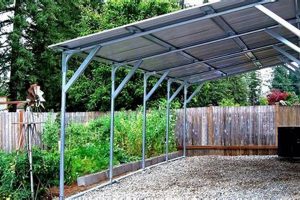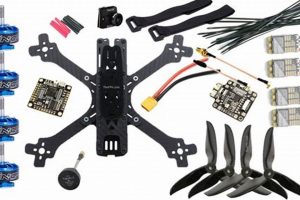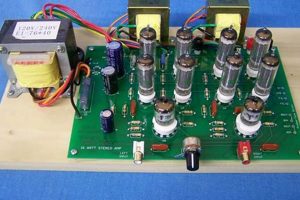A do-it-yourself guitar package provides all the necessary components for an individual to construct their own playable instrument. Typically, these packages contain a pre-shaped guitar body, a neck (often unfinished), hardware such as tuning pegs and a bridge, electronics like pickups and potentiometers, and sometimes strings and a wiring diagram.
The advantages of assembling an instrument from component parts include cost savings compared to purchasing a fully assembled guitar and the opportunity for customization in terms of finish, hardware choices, and electronic configurations. Building an instrument also offers a hands-on learning experience, providing insight into the design and functionality of guitars. Historically, these types of offerings have become increasingly prevalent as individuals seek personalized projects and affordable entry points into instrument ownership.
The following discussion will address various aspects of selecting and assembling such a project, encompassing considerations for skill level, available resources, and desired outcomes to ensure a successful building endeavor.
Assembly and Customization Guidance
The following guidance focuses on optimizing the experience of constructing a personalized stringed instrument from a component package. Careful planning and execution are critical for achieving a satisfactory result.
Tip 1: Inventory Verification: Before initiating the build, meticulously verify the contents of the received components against the provided parts list. Any discrepancies should be reported to the supplier promptly to avoid delays and potential complications during the assembly process.
Tip 2: Thorough Documentation Review: Carefully examine the included instructions, wiring diagrams, and any other provided documentation. A comprehensive understanding of the assembly process is essential for preventing errors and ensuring proper functionality.
Tip 3: Surface Preparation and Finishing: Prior to applying any finish, thoroughly sand the guitar body and neck to achieve a smooth and uniform surface. Proper surface preparation is crucial for achieving a professional-looking and durable finish.
Tip 4: Precise Component Alignment: Take extreme care in aligning the neck with the guitar body, ensuring proper scale length and string alignment. Accurate alignment is critical for achieving optimal playability and intonation.
Tip 5: Secure Hardware Installation: Employ appropriate tools and techniques to securely install all hardware components, such as tuning pegs, bridge, and strap buttons. Loose hardware can compromise the instrument’s functionality and stability.
Tip 6: Electronic Wiring Precision: Exercise caution and precision when wiring the electronic components. Follow the wiring diagram meticulously to avoid short circuits or other electrical issues. Consider using shielded wiring to minimize noise.
Tip 7: Gradual String Tension Adjustment: When stringing the instrument for the first time, gradually increase the string tension to allow the neck to settle. Avoid over-tightening the strings initially, as this can damage the neck or bridge.
These guidelines offer a framework for approaching the assembly of a personalized stringed instrument. Adhering to these recommendations will enhance the likelihood of a successful and rewarding project.
The subsequent section will address troubleshooting common issues encountered during assembly and provide resources for further assistance.
1. Component Quality
Within the context of a do-it-yourself guitar package, the quality of the included components directly influences the instrument’s final playability, sonic characteristics, and longevity. Inferior components can manifest as tuning instability, poor intonation, and a compromised overall tone. For instance, tuning pegs constructed from low-grade materials may slip, rendering the instrument difficult to keep in tune. Similarly, improperly wound or poorly shielded pickups can introduce unwanted noise and a lack of clarity in the amplified signal. The selection of quality components is therefore not merely an aesthetic consideration, but a fundamental determinant of the instrument’s utility and value.
The pre-shaped guitar body and neck are equally critical. A body made from low-density wood can exhibit poor resonance, resulting in a dull and lifeless sound. A neck that is not properly seasoned or reinforced may be prone to warping, leading to intonation problems and requiring extensive adjustments or even replacement. Examples of high-quality components would include a solid body made of hardwoods such as mahogany or ash, and a neck constructed of maple with a truss rod for adjustability. The choice of materials in these core components is a primary driver of the final product’s performance.
In conclusion, the relationship between component quality and the success of a DIY guitar project is inextricably linked. Investing in a package that prioritizes quality parts, even at a slightly higher initial cost, can yield a significantly more satisfying and playable instrument. Conversely, prioritizing cost savings at the expense of component quality often results in an instrument that is frustrating to play and ultimately less rewarding. Diligent research and careful component selection are therefore paramount to achieving a successful outcome.
2. Neck Stability
The stability of the neck in a do-it-yourself guitar construction project is paramount to the instrument’s playability and long-term durability. A stable neck resists warping, twisting, or bending under string tension and environmental changes, ensuring accurate intonation and consistent action. Conversely, an unstable neck can lead to buzzing frets, difficulty in tuning, and an overall compromised playing experience. The choice of wood, truss rod installation, and neck joint construction are critical factors contributing to neck stability within the context of a component-based guitar project. For example, a neck crafted from inadequately dried lumber may exhibit significant movement over time, even with a functional truss rod.
Practical implications of insufficient neck stability are evident in numerous instances. A neck that bows excessively requires frequent truss rod adjustments to maintain acceptable string height. If the bow is too severe, the truss rod may be insufficient to correct it, necessitating costly repairs or even neck replacement. Furthermore, an unstable neck joint, where the neck attaches to the body, can introduce unwanted vibrations and energy loss, negatively impacting the instrument’s sustain and tone. Proper neck-to-body fit and secure fastening are essential for maximizing the instrument’s acoustic performance. Proper neck-to-body fit and secure fastening are essential for maximizing the instrument’s acoustic performance.
Therefore, selecting a do-it-yourself guitar package with
a well-constructed and reinforced neck is a crucial investment. Examining the material specifications and construction methods employed in the neck design can provide valuable insights into its potential stability. While imperfections can be corrected with skill and experience, starting with a structurally sound neck minimizes the risk of future complications and maximizes the likelihood of a successful and enjoyable instrument-building experience. Addressing neck stability proactively ensures an outcome that provides both playability and longevity.
3. Wiring Accuracy
Within a do-it-yourself guitar package, the precision of the electronic wiring is a critical determinant of the instrument’s functionality and tonal characteristics. Inaccurate wiring can result in a non-functional instrument, unwanted noise, or incorrect tonal response from the pickups and controls.
- Signal Path Integrity
The accuracy of the wiring directly affects the integrity of the audio signal path. Incorrect connections, cold solder joints, or improper grounding can introduce noise, signal loss, or even complete signal blockage. For example, a faulty ground connection may result in a noticeable hum, while a reversed connection on a pickup can cause phase cancellation, leading to a thin and weak sound. Precision in following the wiring diagram ensures a clean and unadulterated signal flow from the pickups to the output jack.
- Component Functionality
Wiring accuracy is essential for the proper operation of individual electronic components. Potentiometers, capacitors, and switches must be wired correctly to perform their intended functions. An incorrectly wired potentiometer may exhibit a reversed taper or fail to function as a tone or volume control. Similarly, a miswired switch may fail to select the desired pickup combination or introduce unwanted short circuits. Accurate wiring ensures that each component operates as designed, contributing to the overall functionality and versatility of the instrument.
- Safety Considerations
While the voltages involved in passive guitar electronics are generally low, wiring errors can still pose safety risks. Incorrect wiring can create short circuits or ground loops, potentially damaging components or causing electrical interference. Furthermore, improper grounding can create a shock hazard if the instrument is connected to an amplifier with a faulty ground. Following proper wiring practices and ensuring that all connections are secure and insulated minimizes these risks.
- Troubleshooting and Repair
Accurate wiring facilitates troubleshooting and repair. A well-documented and correctly wired circuit is easier to diagnose and repair than a haphazard or poorly documented one. Clear wiring and neat component placement simplify the identification of faulty connections or components. This ultimately saves time and effort in the long run, making maintenance and upgrades easier to perform.
Ultimately, attention to wiring accuracy is integral to the success of any do-it-yourself guitar construction endeavor. Precise wiring not only ensures the proper functioning of the instrument’s electronics but also contributes to its overall reliability, tone, and ease of maintenance. Taking the time to carefully follow wiring diagrams and employ proper soldering techniques is a worthwhile investment that yields significant dividends in terms of instrument performance and longevity.
4. Finish Application
Within the realm of do-it-yourself guitar projects, the application of a finish serves as a critical step, directly influencing both the aesthetic appeal and the protective qualities of the instrument. A properly applied finish shields the wood from environmental factors such as moisture and temperature fluctuations, thereby contributing to the instrument’s long-term stability. Conversely, a poorly executed finish can detract from the visual appeal and fail to adequately protect the underlying wood. For example, an unevenly applied finish may exhibit runs, drips, or orange peel texture, diminishing the instrument’s perceived value. Similarly, a finish that is too thin may offer insufficient protection against scratches and dings, accelerating wear and tear.
The selection of a suitable finish is also of paramount importance. Different types of finishes, such as lacquer, polyurethane, and oil-based varnishes, offer varying levels of durability, gloss, and ease of application. A lacquer finish, while offering a classic appearance and excellent tonal properties, requires specialized equipment and expertise for proper application. Polyurethane finishes, on the other hand, are more durable and resistant to chemicals but can be more challenging to apply evenly. Oil-based finishes offer ease of application and a natural look but provide less protection than other options. The chosen finish must be compatible with the type of wood used in the guitar body and neck, and the application technique must be tailored to the specific finish. Consider, for example, the need for multiple coats of lacquer applied in thin layers, with careful sanding between coats to achieve a smooth and glossy surface.
In summary, the finish application represents a crucial stage in the creation of a custom stringed instrument. The chosen finish and its subsequent application technique exert a significant influence on both the aesthetic and functional attributes of the instrument. Due diligence in selecting an appropriate finish and employing proper application methods is essential for achieving a professional-quality result and ensuring the instrument’s longevity and playability. Prioritizing this aspect of the building process can significantly elevate the final quality and satisfaction derived from the instrument.
5. Hardware Compatibility
Hardware compatibility constitutes a critical consideration within the context of a do-it-yourself guitar package. Ensuring that all included components are designed to function harmoniously is paramount to a successful instrument build. Incompatibility can lead to functional limitations, aesthetic inconsistencies, and compromised playability.
- Bridge and Body Alignment
The guitar bridge must align properly with the pre-drilled mounting holes on the instrument body. Discrepancies in hole spacing or bridge dimensions can necessitate modifications or, in extreme cases, render the bridge unusable. A misaligned bridge impacts intonation and string spacing, affecting playability and tuning accuracy. For instance, a bridge designed for a different string spacing may cause strings to be too close together or too far apart, leading to discomfort and difficulty in playing chords.
- Tuning Peg Bore Compatibility
Tuning pegs must fit snugly within the pre-drilled holes in the headstock. Pegs that are too large require reaming the holes, potentially damaging the headstock. Conversely, pegs that are too small may not hold securely, leading to tuning instability. A practical example involves vintage-style tuning pegs, which often have smaller posts than modern pegs, and may require conversion bushings to ensure a secure fit
in modern headstock drillings. - Pickup Cavity Dimensions
Pickups must physically fit within the routed cavities on the guitar body. Dimensions should be verified prior to installation to avoid the need for routing modifications, which can alter the instrument’s appearance and potentially affect its structural integrity. An example includes humbucker pickups, which are larger than single-coil pickups and require appropriately sized cavities. Attempting to install a humbucker in a single-coil cavity would require routing, which could damage the body’s finish and structure.
- Control Potentiometer Shaft Length and Body Thickness
Control potentiometers require adequate shaft length to protrude through the instrument body or control plate, allowing for knob attachment. If the shaft is too short, the knob will not seat properly, impacting the control’s functionality and aesthetics. Instances include using short-shaft potentiometers on thick-bodied guitars like Les Pauls, often requiring the use of extension sleeves to ensure proper knob attachment.
Addressing hardware compatibility is an essential prerequisite to embarking on a component-based guitar project. Verification of component dimensions and specifications prior to assembly can mitigate potential issues and ensure a smoother, more successful building experience. Neglecting this aspect can lead to frustration, increased project costs, and a compromised final product. Diligent planning contributes directly to a positive outcome.
6. Scale Length
Scale length, the distance from the guitar’s nut to its bridge saddle, represents a fundamental element in the design and playability of any stringed instrument, including those assembled from do-it-yourself guitar kits. Its accurate specification and implementation are crucial for achieving correct intonation and comfortable string tension. Incorrect scale length compromises the instrument’s tuning accuracy across the fretboard and affects the feel of the strings, ultimately impacting the playing experience.
- Fret Placement Accuracy
Scale length dictates the precise placement of each fret along the fretboard. Minute deviations from the intended scale length can result in significant intonation problems, particularly in the higher registers of the instrument. For instance, if the fret spacing is compressed due to an inaccurate scale length calculation, notes will sound sharp as the player moves up the neck. In do-it-yourself guitar kit construction, careful adherence to the specified scale length and fret spacing is crucial to prevent such issues. Pre-slotted fretboards must be verified for accuracy before installation.
- String Tension and Gauge Considerations
Scale length influences the string tension required to achieve standard tuning. A longer scale length generally necessitates higher string tension for a given tuning and string gauge. Conversely, a shorter scale length allows for lower tension. The selection of appropriate string gauges for the chosen scale length is essential for balancing playability and tone. Building a guitar from a kit requires a thorough understanding of these relationships to ensure that the chosen strings are compatible with the instrument’s scale length and intended tuning. Improper gauge selection can lead to either overly stiff or excessively floppy strings, negatively affecting the playing experience.
- Neck Stability and Truss Rod Adjustment
The scale length, in conjunction with string tension, places stress on the guitar neck. A longer scale length with heavier gauge strings exerts greater force, requiring a robust neck construction and a properly functioning truss rod to counteract the pull. The truss rod allows for adjustment of the neck’s curvature to maintain optimal string height and prevent excessive bowing. In a do-it-yourself project, ensuring that the chosen neck is adequately reinforced and that the truss rod is properly installed and adjusted is crucial for maintaining neck stability and preventing long-term problems. Inadequate neck support can lead to warping and intonation issues, rendering the instrument unplayable.
- Intonation Adjustment Range
The bridge saddle position, adjustable within a limited range, compensates for minor intonation discrepancies arising from string stiffness and action height. An incorrect scale length significantly reduces the effectiveness of this adjustment, making it impossible to achieve accurate intonation across the entire fretboard. When constructing a guitar from a kit, precise scale length measurement and proper bridge placement are critical. If the scale length is off by even a small amount, the available intonation adjustment range may be insufficient to correct the resulting inaccuracies, leading to persistent tuning problems.
The interplay between scale length and these factors underscores its critical role in the creation of a playable and well-intonated instrument from a do-it-yourself guitar kit. Careful attention to scale length during the construction process is essential for achieving a satisfying and functional final product.
7. Setup Precision
Setup precision, in the context of a do-it-yourself guitar project, refers to the meticulous process of adjusting various parameters of the instrument to optimize its playability and intonation. Given that a component-based guitar lacks the fine-tuning typically performed by experienced luthiers on factory-assembled instruments, this step is critically important to achieving a functional outcome. Without precise setup, the instrument may suffer from issues such as string buzzing, high action, difficulty in tuning, and poor intonation across the fretboard. The consequences of neglecting setup precision are evident in many poorly assembled instruments, where the inherent potential of the components remains unrealized due to inadequate adjustment. For instance, a guitar with a well-constructed neck and quality pickups may still be difficult to play and unpleasant to listen to if the string height, neck relief, and intonation are not properly set.
The practical implications of setup precision extend beyond mere playability. A properly set up instrument encourages practice and facilitates musical expression. Conversely, an instrument that is difficult to play can be discouraging, hindering the learning process and limiting the player’s ability to perform. Specific adjustments involved in setup precision include truss rod adjustment to control neck relief, bridge height adjustment to set string action, nut slot filing to ensure proper string height at the nut, and intonation adjustment to compensate for variations in string tension along the fretboard. Each of these adjustments interacts with the others, requiring a systematic and iterative approach to achieve optimal results. Skilled setup technicians rely on specialized tools and techniques to measure and adjust these parameters with accuracy, often utilizing precision gauges and electronic tuners to ensure that the instrument meets specific performance criteria.
In summary, setup precision is not merely an optional add-on but an integral component of a successful do-it-yourself guitar project. Addressing these detailed adjustments transforms a collection of components into a playable instrument. While achieving professional-level setup may require specialized knowledge and exper
ience, understanding the fundamental principles and carefully executing the necessary adjustments can significantly enhance the instrument’s playability, tone, and overall enjoyment. The challenge lies in acquiring the necessary skills and tools, but the rewards, in terms of instrument performance and personal satisfaction, are substantial. This is particularly true given that factory-assembled instruments also can require adjustment after purchase to optimize their playability, regardless of the initial cost.
Frequently Asked Questions About Guitar Assembly Packages
The following questions address common inquiries regarding the acquisition and construction of stringed instruments from component packages. These responses aim to provide clarity on potential challenges and expectations associated with this endeavor.
Question 1: What level of skill is required to successfully assemble a guitar from a do-it-yourself package?
Assembly typically requires a foundational understanding of woodworking, electronics, and basic guitar setup. While prior experience is beneficial, meticulous adherence to instructions and access to online resources can enable individuals with limited experience to complete the project. Patience and attention to detail are crucial attributes for successful assembly.
Question 2: What tools are necessary for assembling a guitar from a package?
Essential tools include screwdrivers, soldering iron, wire cutters, sandpaper, files, a multimeter, and a ruler or measuring tape. Specialized tools, such as fret leveling files and nut slotting files, may be necessary for more advanced setup procedures. Access to a drill press and clamps can facilitate certain aspects of the assembly process. Precision is important.
Question 3: How long does it typically take to assemble a guitar from a package?
Assembly time varies depending on skill level, the complexity of the package, and the desired level of customization. A basic assembly may take approximately 20 to 40 hours. More complex projects, involving custom finishes or intricate wiring, can require significantly longer. Plan accordingly.
Question 4: What are the most common challenges encountered during the assembly process?
Common challenges include incorrect wiring, misaligned components, difficulty in achieving proper intonation, and issues with finish application. Thoroughly reviewing instructions and seeking guidance from online forums or experienced builders can mitigate these challenges. Attention to detail is key.
Question 5: What steps can be taken to ensure a high-quality finish on the assembled guitar?
Proper surface preparation is crucial for achieving a high-quality finish. This involves sanding the wood to a smooth surface and applying a sealer or primer. Selecting a finish that is compatible with the type of wood and following the manufacturer’s instructions carefully are essential. Multiple thin coats, with sanding between coats, typically yield the best results. Adequate ventilation is a must.
Question 6: What resources are available for troubleshooting issues encountered during assembly?
Numerous online resources, including forums, video tutorials, and manufacturer support websites, provide guidance on troubleshooting common assembly issues. Seeking advice from experienced builders or luthiers can also be beneficial. Persistence and a willingness to learn are valuable assets in resolving technical challenges.
These responses highlight the key considerations and potential challenges associated with constructing a stringed instrument from component packages. A thorough understanding of these factors will enable individuals to make informed decisions and approach the project with realistic expectations.
The subsequent section will delve into advanced customization techniques and considerations for optimizing the performance of a self-assembled stringed instrument.
Conclusion
This exploration has illuminated the multifaceted aspects of the do-it-yourself guitar package, underscoring its potential benefits as well as inherent challenges. From the selection of quality components and ensuring neck stability to achieving wiring accuracy, precise finish application, hardware compatibility, accurate scale length, and meticulous setup, each stage demands careful consideration. These factors collectively determine the instrument’s playability, tone, and longevity.
Successful navigation of these complexities empowers individuals to create personalized instruments and fosters a deeper understanding of guitar construction. Continued advancements in component design and online resources promise to further democratize the craft of instrument building, enabling a wider audience to engage in this rewarding endeavor. Careful planning and informed execution remain crucial for maximizing the likelihood of a satisfactory outcome.







